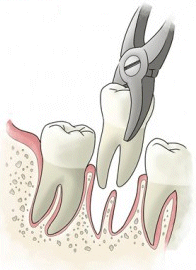
Tooth Extraction Procedure
Tooth extractions require proper preparation, execution and aftercare in order to avoid potential complications and risks.
The difficulty of tooth extractions can vary significantly. A tooth may be pulled easily after only a few minutes effort by the dentist, while another may need more than an hour with surgical intervention by an oral surgeon.
Before the Tooth Extraction Procedure • Preparation
A thorough dental examination is usually performed before a tooth extraction. The dentist also takes the full medical and dental history of the patient.
A tooth extraction is a procedure that requires strong anesthesia and puts the person in a very stressful situation. It is important for the dentist to know if the patient has any medical problems (e.g. heart problems), or any allergies to anesthetics or antibiotic medications. Failure to collect this information before the tooth extraction may put the patient’s life at risk.
An x-ray is required to evaluate properly the condition of the tooth and surrounding tissues. The x-ray will reveal the exact shape and morphology of the tooth roots. It is important also to determine the position of the tooth in relation with the adjacent teeth and its proximity to alveolar nerves. The information will help the dentist to plan properly the procedure. A panoramic x-ray may be needed for multiple teeth extractions.
If the x-rays show that the tooth extraction will be difficult or there is an increased risk of complications, a general dentist may refer the patient to an oral surgeon.
The dentist may prescribe antibiotics to be taken preventively before the tooth extraction procedure, especially in case of surgical or multiple tooth extractions. Antibiotic medication is strongly recommended in case of elderly patients or patients with heart problems or weakened immune system. Any active infections should be controlled or at least suppressed before the tooth extraction to prevent complications.
The Tooth Extraction Procedure
Before starting the tooth extraction procedure, the dentist will provide a strong dose of anesthetic to numb the tooth, jawbone and surrounding gums. The anesthesia is provided by a series of anesthetic injections around the tooth to be extracted. The dentist may also recommend dental sedation to make patients with dental anxiety feel more relaxed and comfortable during the treatment. Available methods include inhalation sedation (nitrous oxide), oral sedation, and iv sedation for the more phobic patients.
The process followed afterwards depends on the type of extraction that is performed. The procedure may be a simple extraction or a surgical extraction.
1. Simple Tooth Extractions
A simple tooth extraction is generally performed on teeth that have enough part of the tooth’s crown in good condition, so that it can be removed with the extraction tools without fracturing. Simple extractions are commonly performed by general dentists under local anesthesia.
In a simple extraction, the dentist grasps the tooth firmly with specialized pliers called ‘extraction forceps’ and moves it back and forth in its socket to loosen it. The bone of the jaw is compressible to some degree. By forcing the tooth against the sides of its socket, the bone in that area becomes compressed. As a result, the socket becomes slightly enlarged and the tooth loosens.
If the tooth is difficult to loosen, an instrument called an ‘elevator’ or ‘luxator’ is used. The elevator is placed between the tooth and the jawbone, in order to break the periodontal ligaments (connective tissues) that keep the tooth attached to the jawbone and expand the tooth socket.
When the tooth is loosened, it can be pulled out of the bone with the forceps. After the tooth is extracted, the dentist will clean carefully the area to remove any puss or debris and will push the loose gum tissue into the empty tooth socket to encourage healing.
2. Surgical Tooth Extractions
Surgical tooth extractions usually involve teeth that do not have enough tooth structure left in good condition above the bone to provide a good grip for the extraction tools, teeth with curved roots and impacted teeth that have not erupted above the gum line.
The oral surgeon makes an incision in the gum and pulls it back to reveal the tooth. If any bone is on the way blocking the extraction path, some of it has also to be removed. As in simple extractions, the connective tissue that holds the tooth in the jawbone has to be broken before pulling the tooth out.
In some cases, the tooth has to be cut or broken into smaller sections to facilitate tooth extraction (tooth sectioning). After the tooth is pulled out, the tooth socket is cleaned carefully from any puss or debris.
The gums are put back in place and stitched (sutured). The stitches will have to be be removed by the dentist a few days after the tooth extraction surgery procedure, unless dissolvable stitches have been used.
Finally, the tooth extraction procedure is completed by placing a wet cotton gauze on the empty tooth socket. The patient is asked to bite down on it hard for the next 30-60 minutes, so as to encourage the formation of a solid blood clot.
Multiple Tooth Extractions
If more than one tooth have to be extracted, many patients prefer to have them removed during the same dental visit, by a multiple tooth extractions procedure. They want to save the time of many dental visits, but the main reason usually is that they want to feel the discomfort just once.
Not everyone is eligible for multiple tooth extractions. The patient must have a good medical health to withstand the increased stress of the multiple extactions.
Multiple tooth extractions are usually done for patients who have extensive and severe periodontal disease. In severe peiodontitis cases the bone loss is so extensive that the jaw bone cannot support the teeth, which become loose. Except of the increased tooth mobility, continuous gum inflammation and dental infections may put in risk the overall health of the patient.
Preparation for full dentures is another reason that multiple tooth extractions are performed. Some of the patients, usually for economic reasons, may choose the solution of full dentures instead of other alternative treatments (e.g. partial dentures or dental implants).
![]() The cost of replacing extracted teeth can be significant and many patients may not afford it if they are not covered by their dental insurance.
Learn how to choose a dental insurance plan that will provide the best dental treatment to you and your family.
The cost of replacing extracted teeth can be significant and many patients may not afford it if they are not covered by their dental insurance.
Learn how to choose a dental insurance plan that will provide the best dental treatment to you and your family.


